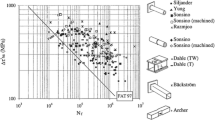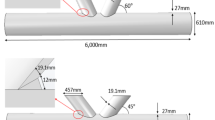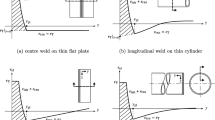Abstract
In this paper a three-dimensional welding simulation was carried out in the FE software ANSYS in order to predict transient temperatures and the residual stresses in a three-pass welded tubular joint structure. The thermal analysis and the moving heat source were verified with temperature measurements, and the computed residual stresses were verified with hole drilling measurements. The calculated and measured temperatures were in good agreement, and the computed residual stresses were in qualitatively good agreement with the experimental results. Residual stress relaxation analyses were carried out with similar load as in earlier fatigue testing on the same tubular joint structure. The FE residual stress relaxation analysis showed a small amount of relaxation early in the fatigue life.
Similar content being viewed by others
References
Barsoum Z., Samuelsson J.: Torsion fatigue and residual stresses in multi-pass welded tubular joints, IIW Document No XIII-2073–05, 2005.
Hansen J.L.: Numerical modeling of welding induced stresses, PhD thesis, Technical University of Denmark, ISBN 87-90855-52–3, 2003.
Humphreys A.E.: Influence of residual stress on the initiation of fatigue cracks at welded piping joints, Master Thesis, Dep. of Civil Eng., North Carolina Sate University, Raleigh, NC, USA, 2004.
Lu X.: Influence of residual stress on fatigue failure of welded joints, Doctoral Thesis, Dep. of Civil Eng., North Carolina Sate University, Raleigh, NC, USA, 2002.
Martinez L.L.: Fatigue behavior of welded high strength steels, Department of Aeronautics, KTH, Report No. 97–30, 1997.
Sanger C.L., Russell J.M., Kurath P.: Prediction of welding residual stresses and redistribution/relaxation due to cyclic loading, SAE International 2004, Paper Nr. 2005-01–1322.
Jonsson M., Karlsson L., Lindgren L.E.: Deformations and stresses in butt-welding of large plates with special reference to the mechanical material properties, J. of Eng. Mat. and Tech., 1985, Volume 107, pp. 265–270.
Wikander L., Karlsson L., Näsström M., Webster P.: Finite element simulation and measurement of welding residual stresses, Modelling Simul. Mater. Sci. Eng., 1994, Volume 2, pp. 845–864.
Hong J.K., Tsai C.L., Dong P.: Assessment of numerical procedures for residual stress analysis of multi-pass welds, Welding Research Supplement, 1998, pp. 372–82.
Goldak J., Bibby M., Moore J., House R., Patel B.: Computer modeling of heat flow in welds, Metallurgical Transaction B, Volume 17B, 1986, pp. 587–600.
ANSYS guide, ANSYS release 10.0, Swanson Analysis Systems: Houston.
Determining residual stresses by the hole-drilling strain-gage method, ASTM Standard E837.
Measurement of residual stresses by the hole-drilling strain gage method, Vishay Measurements group Tech Note, Residual Stresses Measurement, TN-503–4.
Author information
Authors and Affiliations
Rights and permissions
About this article
Cite this article
Barsoum, Z. Residual Stress Prediction and Relaxation in Welded Tubular Joint. Weld World 51, 23–30 (2007). https://doi.org/10.1007/BF03266545
Published:
Issue Date:
DOI: https://doi.org/10.1007/BF03266545




